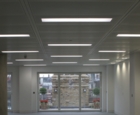Comfort cooling that uses less energy

John Staunton explores the potential of chilled beams and ceilings to reduce energy consumption.
With the current financial crisis affecting all sectors of the construction industry and with a heightened affect on the commercial property market, it is vital that all members of a building’s design team explore a number of alternatives to see how the running costs of new-build projects and the existing building stock can be reduced.
When combined with the likelihood that the 2010 building regulations will demand another 25% reduction in carbon emissions, it is of the utmost importance that specifiers and designers embrace energy-efficient and sustainable technologies.
One option for reducing energy costs was discussed at the 2008 British Council of Offices (BCO) annual conference, where 96% of delegates voted that the next BCO guide on summer office internal temperatures should be revised and moved from 22 to 24ºC. It is estimated that running costs increase between 15 and 20% for every degree that the temperature is lowered.
This is part of a larger industry-wide realisation that it is vital that new solutions need to be found that decrease running and energy costs while still meeting occupier requirements. It has since been reported that the BCO is unlikely to put these recommendations into place because of the current economic situation.
However, the BCO does not need to hold back on revising its guide because these two elements are not necessarily tied to each another, which is evident from examples found throughout the rest of the world. In many places, including Australia and Hong Kong, the recommended summer internal office temperature is already set at a higher level, with standard temperatures ranging from 24ºC to 25.5ºC.
By combining the higher office temperature with an energy-efficient room-comfort system such as chilled beams and ceilings, larger reductions in a building’s running costs can be achieved. It is important that any energy or room-comfort solution specified must still provide a high level of occupant comfort, resulting in an improved level of productivity.
By using chilled water at the relatively high temperatures of 14 to 17°C, chilled ceilings, chilled beams and integrated service modules (ISMs — sometimes referred to as multi-service chilled beams) are a cost-effective and energy-efficient alternative to traditional air-conditioning systems. This means that for large parts of the year water at outdoor temperatures, evaporatively-cooled water or ground-sourced water can be used for cooling.
These reductions can also lead to a reduction in the size (and cost) of the central plant. Although mechanical, the minimal level of refrigeration required not only leads to less electricity being consumed but also to higher room comfort levels due to the minimal noise and air movement.
A 2002 report by the Wales School of Architecture, following two years of research and monitoring, found that the peak energy consumption of chilled-ceiling systems was over 70% lower than that of a traditional fan-coil system. The school also found that chilled ceilings were on average 50% more energy efficient when compared with other air-conditioning types — including all-air, split DX and variable refrigerant flow (VRF) systems.
This experience has led to a significant increase in the number of architects and M&E consultants seeing chilled ceilings and ISMs as the ideal solution for both new-build and refurbishment projects. A recent BSRIA report noted significant changes to the UK air-conditioning market since 2006. It refers to a trend in the terminal-unit market towards a ‘straight fight between fan coils and active chilled beams’.
While not appropriate for every project, there is no reason why this technology cannot be applied to most new and refurbished office developments, as well as within other environments such as schools, universities, airports, hospitals and libraries.
Solutions that also add to a building’s ‘sustainable credentials’ are increasingly demanded by end users, specifiers and architects. Owing to their increased energy efficiency, chilled ceilings, chilled beams and ISMs can help achieve good EPC and DEC ratings and help a building achieve a higher BREEAM rating.
For example, during the redevelopment of 25/27 Queen Anne Street in London, Andrew Lett Architects specified a radiant chilled-ceiling solution from SAS International. The radiant chilled ceiling specified for this project featured factory-fitted apertures for luminaires, removing the need for apertures to be formed on-site, reducing luminaire installation time.
A vital element of this project’s design brief, which led to the specification of the radiant chilled ceiling, was the demand that the floor to ceiling height was maximised to help the building’s owner let the unoccupied office spaces. The chilled ceiling was installed throughout the office, where in some cases the ceiling void was only 100 mm.
John Staunton is room-comfort brand manager with SAS International.









